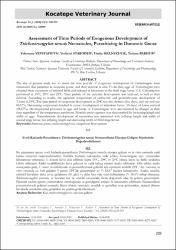Assessment of time periods of exogenous development of trichostrongylus tenuis nematodes, parasitizing in domestic goose
Künye
Yevstafıeva, V. , Starodub, Y. , Melnychuk, V. & Bakhur, T. (2020). Assessment of Time Periods of Exogenous Development of Trichostrongylus tenuis Nematodes, Parasitizing in Domestic Goose . Kocatepe Veterinary Journal , 13 (3) , 228-233 . DOI: 10.30607/kvj.720849Özet
The aim of present study was to assess the time periods of exogenous development of Trichostrongylus tenuis
nematodes that parasitize in domestic goose, and their survival in vitro. To do that, eggs of Trichostrongylus were
obtained from excrement of infected birds and cultured in laboratory to the third stage larvae (L3). Culturing was
performed at 150C, 200C and 250C. Time periods of the parasitic development was analyzed, as well as their
survival. According to results, the optimum temperature of embryonic and postembryonic development of
T.tenuis is 250C. The time period of exogenous development at 250C was the shortest (five days), and survival was
83.67%. Decreasing temperature resulted in slower development of infectious larvae (10 days) of lower survival
(58.67%). Developmental processes in eggs and larvae of Trichostrongylus were accompanied by changes in their
sizes regardless of the temperature conditions. Parasitic embryogenesis was characterized by increasing length and
width of eggs. Postembryonic development of nematodes was associated with inflating length and width of
second stage larvae, but inflating length and decreasing width of third stage larvae. Bu çalışmanın amacı, evcil kazlarda parazitlenen Trichostrongylus tenuis'in eksojen gelişim ve in vitro ortamda canlı
kalma sürelerini değerlendirmektir. Enfekte kuşların dışkısından izole edilen Trichostrongylus spp. yumurtaları
laboratuvar ortamında 3. dönem larva elde edilmek üzere 150C, 200C ve 250C olmak üzere üç farklı sıcaklıkta
kültür edilmiştir. Farklı sıcaklıklardaki larva gelişimi ve canlı kalma süreleri analiz edilmiştir. Elde edilen analiz
sonuçlarına göre, T. tenuis’ in embriyonik ve postembriyonik gelişimi için optimum sıcaklık 250C ' dir. Larvalar, in
vitro ortamda en hızlı gelişimi 5 günde 250C'de göstermişler ve % 83.67 hayatta kalmışlardır. Azalan sıcaklık,
enfektif larvaların daha yavaş gelişimine (10 gün) ve daha kısa süre canlı kalmalarına (% 58.67) sebep olmuştur.
Trichostrongylus yumurta ve larvaları her üç sıcaklık ortamında, farklı değerlerde olsa da gelişim göstermiştir.
Parazitik embriyogenez, yumurtaların uzunluğunun ve genişliğinin artması ile karakterize edilmiştir. Nematodların
postembriyonik gelişimi sırasında, ikinci dönem larvalarda uzunluk ve genişlikte artış gözlenirken, üçüncü dönem
larvalarda uzunlukta artış, genişlikte ise azalma gözlemlenmiştir.
Kaynak
Kocatepe Veteriner DergisiCilt
13Sayı
3Bağlantı
https://dergipark.org.tr/tr/pub/kvj/issue/55009/720849https://doi.org/10.30607/kvj.720849
https://hdl.handle.net/11630/9381
Koleksiyonlar
- Cilt 13 : Sayı 3 [14]



















